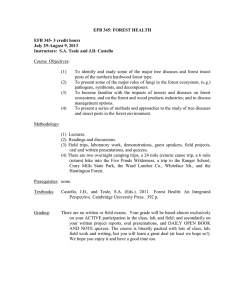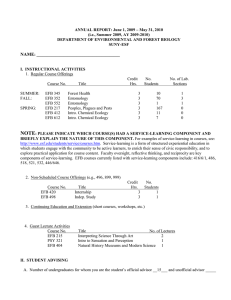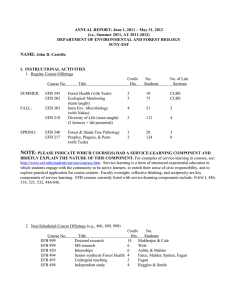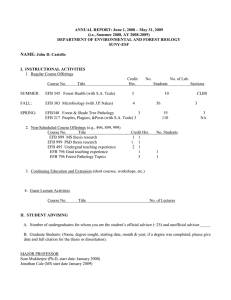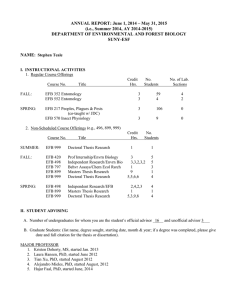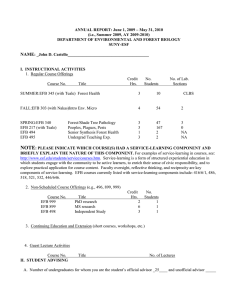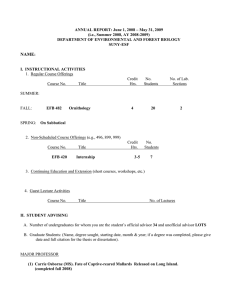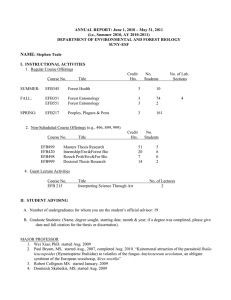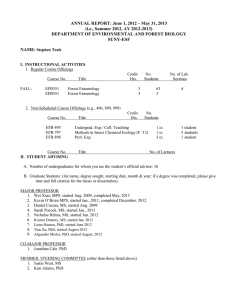ANNUAL REPORT: June 1, 2008 – May 31, 2009
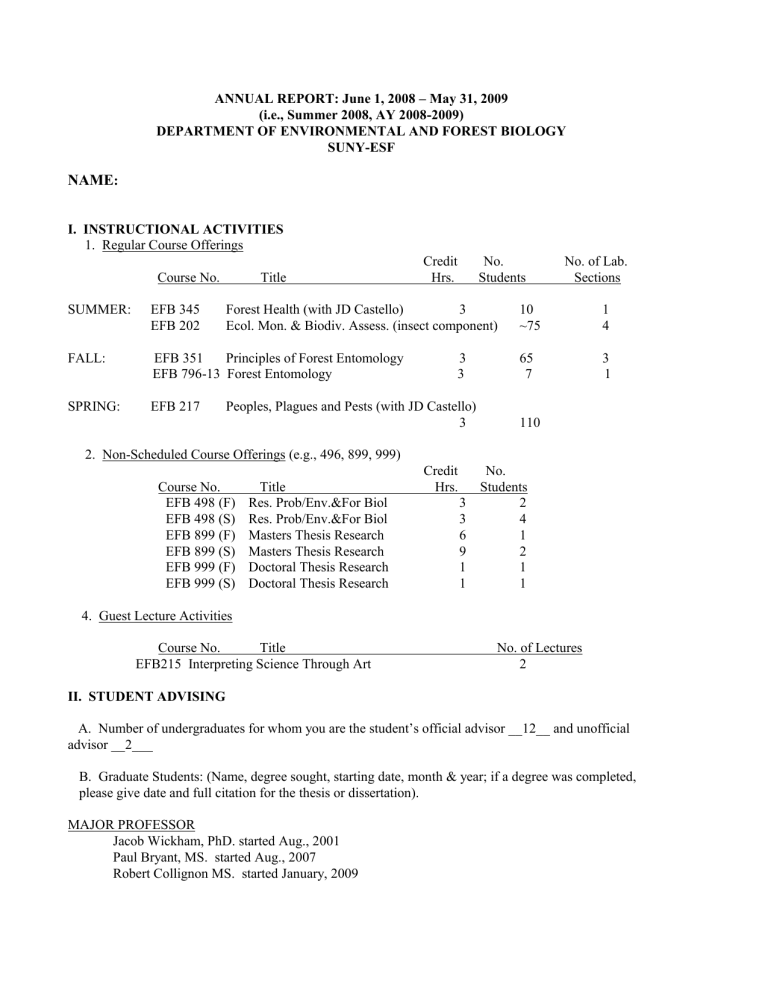
ANNUAL REPORT: June 1, 2008 – May 31, 2009
(i.e., Summer 2008, AY 2008-2009)
DEPARTMENT OF ENVIRONMENTAL AND FOREST BIOLOGY
SUNY-ESF
NAME :
I. INSTRUCTIONAL ACTIVITIES
1. Regular Course Offerings
Credit No. No. of Lab.
Course No. Title Hrs. Students Sections
1
4
SUMMER: EFB 345 Forest Health (with JD Castello)
EFB 202
3
Ecol. Mon. & Biodiv. Assess. (insect component)
10
~75
FALL: EFB 351 Principles of Forest Entomology 3 65
EFB 796-13 Forest Entomology 3 7
SPRING: EFB 217 Peoples, Plagues and Pests (with JD Castello)
3 110
3
1
2. Non-Scheduled Course Offerings (e.g., 496, 899, 999)
Course No. Title
EFB 498 (F) Res. Prob/Env.&For Biol
EFB 498 (S) Res. Prob/Env.&For Biol
EFB 899 (F) Masters Thesis Research
EFB 899 (S) Masters Thesis Research
Credit No.
Hrs. Students
3
3
6
9
1
1
2
4
1
2
1
1
EFB 999 (F) Doctoral Thesis Research
EFB 999 (S) Doctoral Thesis Research
4. Guest Lecture Activities
Course No. Title
EFB215 Interpreting Science Through Art
No. of Lectures
2
II. STUDENT ADVISING
A. Number of undergraduates for whom you are the student’s official advisor __12__ and unofficial advisor __2___
B. Graduate Students: (Name, degree sought, starting date, month & year; if a degree was completed, please give date and full citation for the thesis or dissertation).
MAJOR PROFESSOR
Jacob Wickham, PhD. started Aug., 2001
Paul Bryant, MS. started Aug., 2007
Robert Collignon MS. started January, 2009
CO-MAJOR PROFESSOR
Steve Letkowski (with John Castello), completed May, 2009 (Aug. degree date)
MEMBER, STEERING COMMITTEE (other than those listed above)
Kim Adams (PhD)
Patrick Eager (MS)
Jonathan Cale (MS)
III. RESEARCH COMPLETED OR UNDERWAY
A. Departmental Research (unsupported, boot-legged; title - % time spent)
1.
Beech bark disease 10% – Several aspects incl. (1) relationship between the scale insect and the fungal pathogen, (2) impacts of beech thickets on forest biodiversity, (3) development of a digital image analysis methodology for measuring scale insect density, and (4) development of systemic insecticidal treatment for manipulating scale insect density.
2.
Sugar maple borer pheromone identification – 2%
3.
Semiochemicals for Laricobius nigrinus , an introduced predator of the hemlock woolly adelgid –
2% L. nigrinus is the principal biological control agent for HWA yet determination of its establishment and dispersal has been problematic due to the lack of an effective field sampling method. This project is the first step in developing a sampling protocol. This is currently a pilot project and the preliminary results will be used to leverage funding.
4.
Chemical attractants of Philornis downsi – 5%. This insect is a parasitic fly that attacks neonate passerine birds. It has been unintentionally introduced from South America to the Galapagos
Islands where it is causing high levels of mortality among several bird species including “Darwin’s finches” and the endangered mangrove finch which is down to ~50 breeding pairs. There is an urgent need for an effective means of control that will not adversely affect non-target organisms.
This is currently a pilot study being conducted in collaboration with scientists from the Charles
Darwin Foundation; we plan to go for full funding of the project in the coming year.
5.
Pheromones of the American burying beetle – 5%. ABB is a federally listed endangered species of carrion-feeding beetle. I am working with two undergraduates to identify the sex pheromone of this species in order to develop a more effective population monitoring tool.
6.
Contact pheromones of pine weevils – 2% Pissodes strobi and P. nemorensis are two sibling species that are able to hybridize but rarely do so in nature. We are looking at cuticular hydrocarbons as possible cues involved in premating isolation.
B. 1. Grant-supported Research (source, subject, amount - total award and current year, award period starting and ending dates; list graduate research assistants supported by each grant)
1.
Teale, S.A., Asian Longhorn Beetle Research at SUNY-ESF, Alphawood Foundation,
$85,874, 2/1/08 – 1/31/10 (supported Jake Wickham)
2.
Teale, S.A., European Woodwasps (Sirex noctilio) in North America: Impacts and
Pheromones. McIntire-Stennis, $57,657, 08/15/2007 - 9/30/2009 (supporting Max
Collignon)
3.
Lindi J. Quackenbush and Stephen A. Teale, Remote Sensing Based Classification of
Forests Infested by Sirex Woodwasp. McIntire-Stennis $78,236 08/15/2008 to 9/30/2011
4.
Teale, S.A., Asian Longhorn Beetle Research at SUNY-ESF, Alphawood Foundation,
$90,432, 2/3/09 – 2/2/11 (supported Jake Wickham)
2. Research Proposals pending (as in B.1., above)
1.
Quackenbush, L., Im, J., Teale, S.A., and van Aardt, J. Multiscale remote sensing tools to support management of invasive insect outbreaks, Northeastern States Research
Cooperative, $96,377, 7/1/09 – 6/30/11
2.
McNulty, S.A., J.D. Castello and S.A. Teale. The influence of American beech thickets on biodiversity in the northern hardwood forest. Northeastern States Research Cooperative,
$34,785, 10/1/09 – 9/30/10
3.
Im, J., L. Quackenbush and S.A. Teale. Characterization of Forests Infested by Sirex noctilio Using Hyperspectral Remote Sensing. U.S. Forest Service, $75,000, 8/1/09-
7/31/11
4.
Teale, S.A., J.D. Castello and J. Millar. Fungal Attractants for Parasitoids of Sirex noctilio . $75,000, 8/1/09-7/31/10
IV. PUBLICATIONS (Full bibliographic citation, i.e., do not use "with Jones," or "Jones, et al."; please list only publications published, in press, or actually submitted during this reporting period --- do not list manuscripts in preparation ).
A. Refereed Publications
Teale, S.A., S. Letkowski, G. Matusick, S.V. Stehman, and J.D. Castello. In press.
Quantitative, nondestructive assessment of beech scale (Hemiptera:
Cryptococcidae) density using digital image analysis of wax masses. Environ.
Entomol.
B. Non-refereed Publications
Wickham, J.A. and S.A. Teale. In press. Field Response of the Asian Longhorn Beetle to
Host and Female Volatiles. in McManus, K. and K.W. Gottschalk, Proceedings
20 th USDA Interagency Research Forum on Invasive Species, Forest Service
Northern Research Station, General Technical Report.
C. Papers Presented at Science Meetings (give title, date, occasion, and location)
Teale, S.A. Chemical attractants in the management of non-native forest insects. October
30, 2008. Invasive Non-Native Forest Pest Conference, Ithaca, NY.
Wickham, J.A. and S.A. Teale. Field Response of the Asian Longhorn Beetle to Host and
Female Volatiles (Poster). 20 th USDA Interagency Research Forum on Invasive
Species. Annapolis, MD, January 13-16, 2009.
D. Public Service Presentations (lectures, seminars, etc. to and for the public; give group or occasion, date(s), and attendance)
Teale, S.A. Chemical ecology of recent invasive forest insects in New York. March 24,
2009, Department of Entomology, NYS Agri. Expt. Sta., Cornell Univ. Geneva,
NY.
Teale, S.A. Forest Health and Wildlife Populations. NY Chapter of The Wildlife Society
Annual Meeting, February 20, 2009 Syracuse, NY
V. PUBLIC SERVICE
B. Unfunded Service to Governmental Agencies, Public Interest Groups, etc.
Insect identification services to the Onondaga County Medical Examiner
Interview with Channel 9 TV re: Asian longhorned beetle, 29 May, 2009
Interview with Channel 9 TV re: NYS-DEC restrictions on total release foggers (flea bombs), October 17, 2008,
VI. PROFESSIONAL DEVELOPMENT
B. 2. Professional Society Membership
International Society of Chemical Ecology
Entomological Society of America
3. Other Professional Activities b. Reviewer
Journal(s)
Environmental Entomology
J. Chemical Ecology
Oxford Univ. Press (textbook review)
No. of manuscripts
1
1
1
Agency
USDA-CSREES-SBIR
USDA-McIntire-Stennis
No. of proposals
1
1
VII. ADMINISTRATIVE AND SERVICE RESPONSIBILITIES (include committee participation)
A. Department-level
Chair, Field Programs Committee
VIII. SUMMARY OF SIGNIFICANT ACTIVITIES AND ACCOMPLISHMENTS DURING THIS
REPORTING PERIOD, ESPECIALLY THOSE MOST NOTEWORTHY AND RELATIVE TO
THE COLLEGE’S AND DEPARTMENT’S MISSION. One paragraph on each of the following would be most helpful: this past year, what have you done for our students, department/college, and self professionally? NOTE: The information in this section (along with the supporting specific information elsewhere in this report) should be your strongest case for being considered for a discretionary raise, which
I’ll continue to award based on your contributions to the department and college this reporting period.
1.
John Castello and I have made good progress on our Forest Health textbook. We have edited first or second drafts of most of the chapters and have written various drafts of our own chapters. We are experiencing one anticipated benefit of this project: bringing together ecologists and foresters and finding common ground on issues where previously there appeared to be contradictory views. The book will be a fresh synthesis of the field and has the potential to influence the way students, practitioners and academics view forest health.
2.
Our new course, EFB 217 Peoples, Plagues and Pests was very successful. The enrollment was well beyond our expectations and unsolicited, informal feedback was uniformly positive. Given the amount of work involved in putting a course like this together, the response was encouraging. Our students received rigorous instruction in the history of the non-western world together with an education on the influence of human, plant and animal disease on the course of history, and vice-versa. Their eyes were also opened to the world of invertebrates and microorganisms and the decisive roles they play
in human ecosystems. Lastly, the students were clearly grateful that they had expanded options in the ‘other world civilizations’ category of the General Education requirements.
3.
Another new (for me) course was EFB 351 Principles of Forest Entomology which I taught in the fall semester. This course also had solid enrollment: 65 undergrads and 7 graduate students. I redescribed and restructured the introductory entomology course offerings so that both the Entomology (EFB 352) and Forest Entomology (EFB351) courses have graduate counterparts (EFB 552 & EFB 551, respectively). Pre-enrollments for EFB 352 in fall of 2009 are 72; up dramatically from 47 in 2007.
4.
The chemical ecology/conservation biology connection is developing well. One of my grad students, Max Collignon, spent several weeks in the Galapagos studying the chemical ecology of a parasitic fly that is devastating populations of Galapagos finch species. Two newly recruited grad students will begin other chemical ecology projects of conservation concern in the near future.
IX. A. FUTURE PLANS, AMBITIONS, AND POTENTIAL CONTRIBUTIONS FOR YOUR OWN
PROFESSIONAL DEVELOPMENT AND THE ENHANCEMENT OF THE PROGRAM IN
ENVIRONMENTAL AND FOREST BIOLOGY (brief summary)
I plan to continue the new activities that I began this past year. The major efforts will be
1.
working on the Forest Health textbook,
2.
teaching Chemical Ecology again next spring, and
3.
my Asian longhorned beetle project which continues to be a significant effort.
B. PROJECTED ACTIVITIES FOR NEXT YEAR
1. Summer 2009 a. Course(s) to be offered
EFB 345 Forest Health
EFB 202 Ecol. Mon. & Biodiv. Assess. (insect component) b. Proposed research activity
Continue all projects listed in III A & B c. University, professional society, and public service
Resume activities of the Field Program Committee
2. Fall Semester 2009
a. Course(s) to be offered
EFB 352 Entomology
EFB 552 Entomology b. Proposed research activity
Continue all projects listed in III A & B
3. Spring Semester 2010 a. Course(s) to be offered
EFB 412/612, FCH 440 Chemical Ecology
EFB 217 Peoples, Plagues and Pests b. Proposed research activity
Continue all projects listed in III A & B
